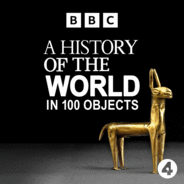This week Neil MacGregor is exploring the growing importance of agriculture around the world at the end of the Ice Age, with objects that show and celebrate the key elements of the time; power, sex, worship and food. Today the series focuses on the world of the Mayan civilisation and a stone Maize God, discovered on the site of a major Mayan city in present-day Honduras. This large statue is wearing a headdress in the shape of a giant corn cob. Maize was not only worshipped at that time but the Maya also believed that all their ancestors were descended from maize. Neil MacGregor reveals why maize, which is notoriously difficult to refine for human consumption, becomes so important to the emerging agriculture of the region. Neil is joined by the anthropologist Professor John Staller and the restaurateur Santiago Calva who explain the complexity of Mayan mythological belief and the ongoing power of maize in Central America today

Kultur & Literatur
A History of the World in 100 Objects Folgen
Director of the British Museum, Neil MacGregor, narrates 100 programmes that retell humanity's history through the objects we have made.
Folgen von A History of the World in 100 Objects
101 Folgen
-
Folge vom 28.01.2010Maya Maize God Statue
-
Folge vom 27.01.2010Egyptian Clay Model of CattleNeil MacGregor, in his history of mankind as told through objects at the British Museum, selects four miniature clay cows to show the major changes that early man was undergoing at the end of the Ice Age. These four frail looking cows were made from Nile mud in Egypt 5,500 years ago, way before the time of the pyramids or the pharaohs. Why did the Egyptians start burying objects like this one with their dead? Neil goes in search life and death on the Nile and discovers how the domestication of cattle made the humble cow transformed human existence.
-
Folge vom 26.01.2010Ain Sakri Lovers FiguerineThe British Museum's Director, Neil MacGregor, investigates a palm-sized stone sculpture that was found near Bethlehem. It clearly shows a couple entwined in the act of love. The contemporary sculptor Marc Quinn responds to the stone as art and the archaeologist Dr Ian Hodder considers the Natufian society that produced it. What was human life and society actually like all those years ago? Possibly a lot more sophisticated than we imagine!
-
Folge vom 25.01.2010Bird-shaped PestleNeil MacGregor continues his retelling of human history using 100 selected objects from the British Museum. This week he explores the profound changes that humans experienced at the end of the Ice Age. By this period, humanity is reconsidering its place in the world and turning its attention to food, power, worship, and human relationships.But then, as now, one of the most important parts of human existence was finding enough food to survive. Taking a pestle from Papua New Guinea as an example, Neil asks why our ancestors decided to grow and cook new foods. The answer provides us with a telling insight into the way early humans settled on the land. Becoming farmers and eating food that was harder for other animals to digest made us a formidable force in the food chain. The impact on our environment of this shift to cookery and cultivation is still being felt.Neil is joined by Indian food writer Madhur Jaffrey, campaigner Sir Bob Geldof and archaeologist Professor Martin Jones
